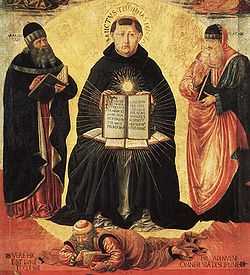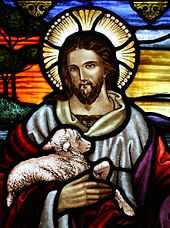Theological virtues
| Part of a series on |
| St. Thomas Aquinas |
|---|
 |
|
|
Theological virtues - in theology and Christian philosophy, are the character qualities associated with salvation, resulting from the grace of God, which enlightens the human mind.[1]
In the Bible
The three theological virtues are:
- Faith - belief in God, and in the truth of His revelation as well as obedience to Him (cf. Rom 1:5:16:26)[2][3]
- Hope - expectation of and desire of receiving; refraining from despair and capability of not giving up. The belief that God will be eternally present in every human's life and never giving up on His love.
- Charity - a supernatural virtue that helps us love God and our neighbors, more than ourselves.
These virtues are bestowed upon human beings during baptism. (1 Tim 2:4 & Jn 3:5) They help individuals grow in their relationship with God with each act they commit that exhibits one of these virtues.
- "[He] desires all men to be saved and to come to the knowledge of the truth". 1 Tim 2:4 (Douay-Rheims Bible, 1582).
- "Unless one is born of water and the Spirit, he cannot enter the kingdom of God". Jn 3:5 (Douay-Rheims Bible, 1582).
They are referenced and qualified in the Bible at 1 Corinthians 13:13:
- "And now abideth faith, hope, and love, even these three: but the chiefest of these is love". (Geneva Bible, 1560).
- "Three things will last forever—faith, hope, and love—and the greatest of these is love". (New Living Translation, 2007).
The English word love for the third and greatest of the virtues, ἀγάπη (agapē), was used by all of the English translations of the Bible in the 16th Century, including the Tyndale Bible (1534), the Bishops' Bible (1568), and the Geneva Bible (1560). It is also used by almost all current translations of the Bible, including the New King James Version, the New American Standard Bible, and the New International Version.
The King James Version (1611) and the Challoner Douay Rheims Bible (1752) prefer the more theological term charity for the same idea of specifically Christian love.
Catholic theology
In Catholic theology, it is held that these virtues differ from the cardinal virtues in that they can not be obtained by human effort. A person can only receive them by their being "infused"—through Divine grace—into the person.
The theological virtues are so named because the object of these virtues is the divine being (theos). Other virtues have vice at their extremes, and are only virtues when they are maintained between these extremes. In the case of the Theological Virtues, they do not contribute to vice at the positive extreme; that is, there is no vice in having an unlimited amount of faith, hope, or love, when God is the object of that virtue.
More than one vice can be the opposite of each theological virtue:
- Lack of faith may give place to incredulity (as in atheism and agnosticism), blasphemy or apostasy.
- Lack of hope may give place to despair or cynicism.
- Lack of love may give place to hatred, wrath or indifference.
Symbolism

Theological Virtues are often depicted in art as young women. The symbols most often associated with them are:
- Faith - cross, pointing upward, staff and chalice, lamp, candle, hands together with fingers extended together
- Hope - anchor, harp, flaming brand, palm, hands with fingers closed interdigitated
- Love - flaming heart, with children, gathering fruit, hands crossed over heart
For an example of this, the stained glass[4] at St. Martin's Church in Brampton, Carlisle.
Books
- Paradise Restored - The Social Ethics of Francis of Assisi, A Commentary on Francis's 'Salutation of the Virtues', by Jan Hoebrichts, Franciscan Institute Publications, 2004. ISBN 978-0-8199-1008-0
See also
- 1 Corinthians 13
- Cardinal virtues
- Seven deadly sins (cardinal sins)
- Seven virtues,
| Wikimedia Commons has media related to First Epistle to the Corinthians. |
- Christian ethics
- Pope Benedict XVI wrote three encyclicals about the theological virtues: Deus caritas est (about love), Spe salvi (about hope), and Lumen fidei (about faith : this encyclical was written both by Pope Benedict XVI and by Pope Francis).[5]
References
- ↑ Cf. Second Council of Orange ch.5-7; H.J. Denzinger Enchiridion Symbolorum et Definitionum, 375-377
- ↑ Pickar, C. H. (1981) [1967]. "Faith". The New Catholic Encyclopedia 5. Washington D.C. p. 792.
- ↑ Catechism of the Catholic Church n. 2087
- ↑ Visitcumbria.com
- ↑ Speciale, Alessandro (4 July 2013). "The light of faith: origin, history and horizon of the christianism". La Stampa (Turin). Retrieved 19 October 2013.
External links
- The Virtues - Catechism of the Catholic Church
- Contrary, Heavenly, and Cardinal Virtues
| |||||||||||||||||||||||||||||||||||||||||||||||
e

